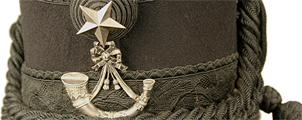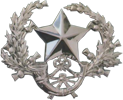Why we remember
Tomorrow is Friday 11th November – the 98th anniversary of the signing of the Armistice concluding the hostilities of the First World War. At 11am tomorrow morning, people all over the country will stop what they are doing to observe the anniversary in a moment of silent reflection. On Sunday 13th, Remembrance Sunday, services will be held nationwide to commemorate those who died in conflict, past and present.
Many of the Remembrance events that will take place over the weekend will be centred around the First World War, and in particular the Battle of the Somme which ran from 1st July to 18th November 1916. Of course, the fighting in 1916 was not confined exclusively to the Somme region, nor indeed to the Western Front. This letter from the museum collection reminds us that the First World War was indeed a global conflict, and reminds us of the loss and sacrifice that comes with War.

The letter was written to the mother of William Williamson, who was killed on 19th November 1916, by the officer commanding William’s company, Captain Frank Scougal. William was part of the 11th Scottish Rifles – a battalion of Kitchener’s Army serving at that time in Salonika, now part of Greece. In the letter, Captain Scougal explains that William died while trying to assist a friend, Sinclair, who had been badly wounded. Both men were killed by shellfire and were buried in Karasouli Military Cemetery.
Sadly, Frank Scougal did not survive the War; he was killed on 19th September 1918, just weeks before the signing of the Armistice. Tragically, Frank’s younger brother, Alec, had been killed the day before while serving on the Western Front. It is testament to the scale of the loss witnessed in the First World War that one short letter can come to represent the grief suffered by so many families.
Comments:
‘Next of Kin’ exhibition – downloadable app

As a proud partner of the National Museums Scotland touring exhibition ‘Next of Kin: Scottish Families and the Great War’, we are pleased to announce that NMS have launched two downloadable apps relating to the exhibition. With the launch of these two apps, First World War content contributed by all Next of Kin tour partners is now available to online audiences across the UK and abroad.
For more information on the apps and how to download them, please take a look at the Next of Kin blog on the NMS website:
Discover the Scottish story of the First World War through Next of Kin apps
You can also explore many of the stories featured in the Next of Kin exhibition through the Historypin website, here.
The Next of Kin exhibition is still on tour around Scotland; you can visit the exhibition at Inverness Museum and Art Gallery until Saturday 5th November. From 11th November you can visit the exhibition at Perth Museum and Art Gallery, and at the Black Watch Museum and Castle.
Comments:
The Battle of the Somme
Today marks the 100th anniversary of the commencement of The Battle of the Somme, fought from 1st July to 18th November 1916. The campaign was fought in the region of the River Somme in France, after which it is named. Although called The Battle of The Somme, it was actually a series of bitter battles fought to control the towns, villages, and woods in the Somme region, as the British and French armies sought to break the German lines. Today, the Battle of the Somme is often associated with the high casualties incurred on both sides. The Battle also witnessed the first use of Tanks in action, used by the British Army on 15th September at the Battle of Flers-Courcelette.
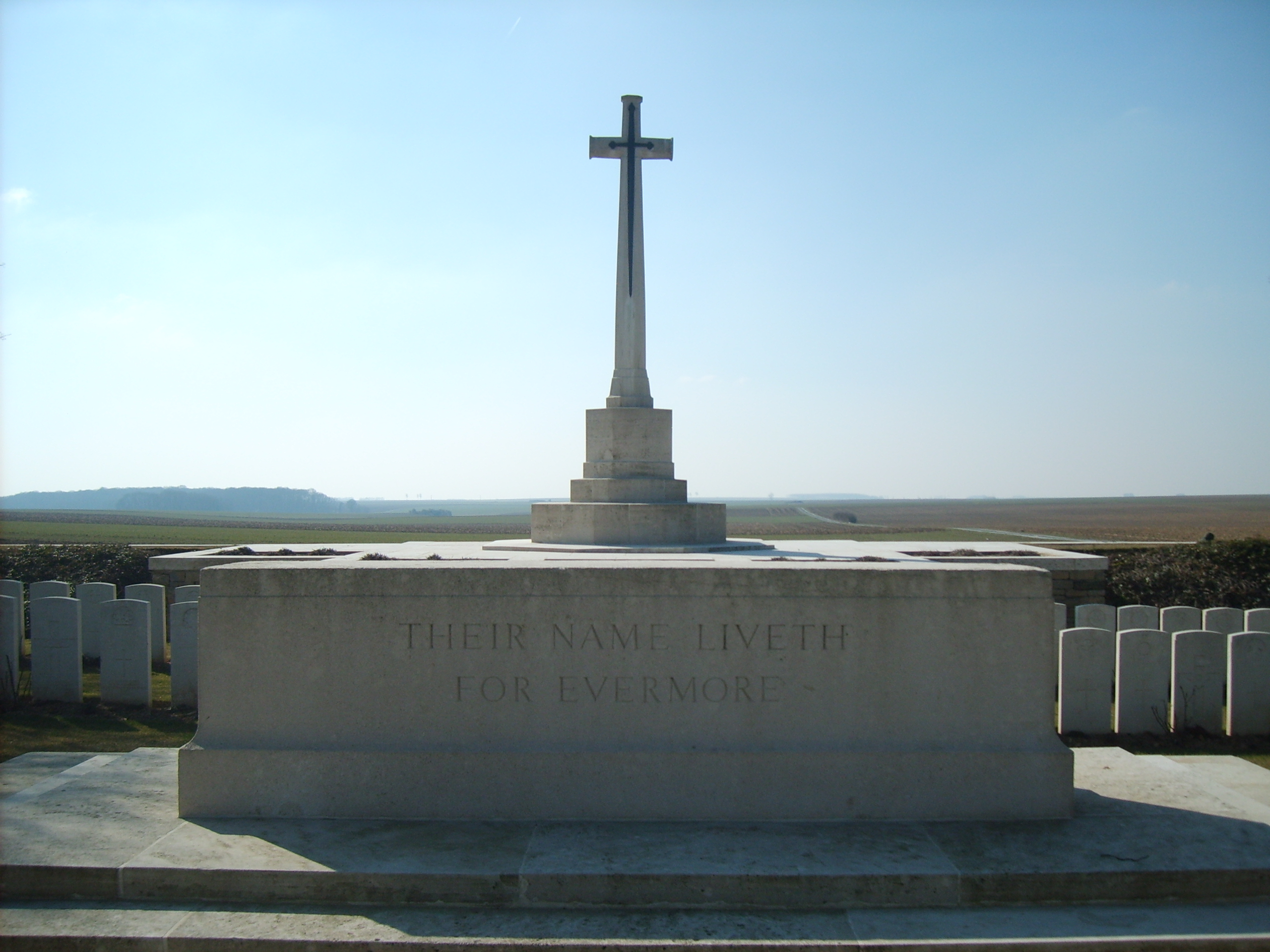
Grove Town Cemetery, Meulte, near Albert, where some of the British soldiers who died in the Battle are buried, including Sergeant Major Chalmers MC DCM of the 2nd Battalion Scottish Rifles.
All battalions of The Cameronians (Scottish Rifles) serving on the Western Front would take part in the Somme campaign at some stage; the 9th Battalion at Montauban in early July, the 1st and 5/6th Battalions at High Wood on 20th July, the 10th Battalion’s capture of Martinpuich on 15th September, and the 2nd Battalion’s attacks at Hazy Trench in October to name but a few.
Over 1000 men of all ranks of The Cameronians (Scottish Rifles) lost their lives during the Battle of the Somme. They are buried in the dozens of cemeteries scattered across the length and breadth of the battlefield. Those whose remains were never found or whose graves were subsequently lost are commemorated on memorials to the missing, such as that at Thiepval, where the names of over 70,000 British and Commonwealth soldiers who lost their lives on the Somme are recorded.
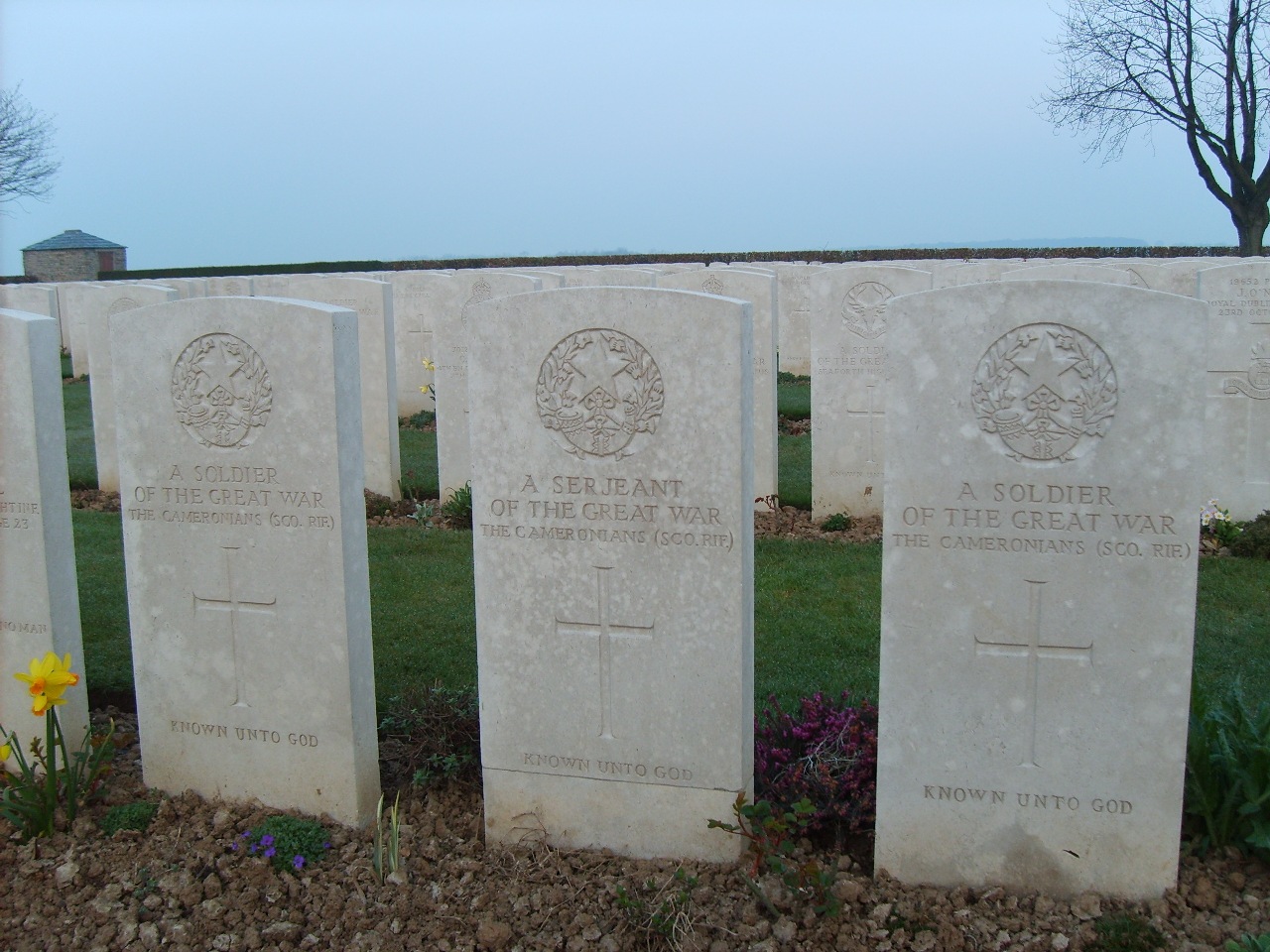
Graves of unknown Cameronian soldiers in Caterpillar Valley Cemetery, near Longuveal.
In Low Parks Museum, Hamilton, you can see a small display of objects from the museum collection that relate to The Cameronians and the Battle of the Somme. Why not also join us on Thursday 14th July for an illustrated talk on the Battle, which will be followed by a screening of Geoffrey Malins’ film The Battle of The Somme, shown courtesy of the Imperial War Museum. The talk will take place at Low Parks Museum on Thursday 14th July at 11:00am, tickets cost £2.00. To book your tickets, please email or telephone Rhona McKinnon:
Rhona.McKinnon@southlanarkshireleisure.co.uk Tel: 01698 476180
Entry to the showing of The Battle of the Somme is free; the film is due to start at 12:00 noon on Thursday 14th July at Low Parks Museum.
Please keep checking the blog for more updates and articles relating to The Cameronians (Scottish Rifles) museum collections.
Comments:
Sergeant John Erskine VC
One hundred years ago today, Sergeant John Erskine performed the deeds that would earn him the Victoria Cross, Britain’s highest award for gallantry in the face of the enemy. At the time, John was a Lance Corporal, Acting Sergeant, serving with the 5th Battalion The Cameronians (Scottish Rifles), a Territorial Force battalion whose headquarters were in the west end of Glasgow.

Men of the 5th Scottish Rifles, somewhere in France. John Erskine (11) is second right, middle row.

John Erskine, on the right, in a ‘dug-out’, while a comrade prepares their rations.
The war diary for the 5/6th Scottish Rifles of 22nd June 1916 records:
“In the early morning, one of the largest mines ever put up on the Western front was blown at the Duck’s Bill, by the Germans, and followed by one hour’s intense bombardment of the front and support lines. The enemy attacked with about 200 men and got into our trenches, but were very gallantly counter-attacked and driven out by the 2nd Royal Welsh Fusiliers. A company of the Royal Welsh Fusiliers who had had most of the fighting was relieved by a company of Cameronians, which in turn was relieved by “A” Company of Ours. LIEUT. STEVENSON, the Sapping Officer, was killed by a sniper while assisting in the consolidation of the crater. LANCE-CORPORAL ERSKINE was successful in bringing in two wounded men, and very gallantly went out over the open and attended to LIEUT. STEVENSON, lying beside him until a shallow trench had been dug to the spot where he lay, whereby he was brought into the trenches.”
For his actions that day, John had been recommended for the Victoria Cross. The London Gazette of 5th August 1916 confirmed the award, with the accompanying citation:
“On 22nd June 1916 at Givenchy, France, whilst the near lip of a crater caused by the explosion of a large mine was consolidated, Sergeant Erskine rushed out under continuous fire and rescued a wounded Sergeant & a Private. Later seeing his officer, who was lying in No-Man’s Land believed dead, showing signs of life, he ran to him, bandaged his head and remained with him for fully an hour, being repeatedly fired on. When assistance arrived, he helped bring the officer in, shielding him with his body to lessen the chance of him being hit again.”
John’s Victoria Cross medal forms part of the regimental museum collections of The Cameronians (Scottish Rifles), and can be seen on display in Low Parks Museum, Hamilton.
-

-
John Erskine’s Victoria Cross
-
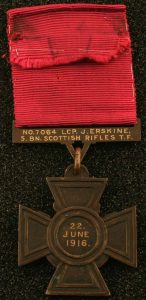
-
The inscription on the reverse of the medal
John Erskine did not survive the First World War. He was killed in action on 14th April 1917, still serving with the 5th (by this time 5/6th) Battalion Scottish Rifles. John has no known grave and is commemorated on the Memorial to the Missing at Arras. John’s younger brother, William, had been killed in November 1916, serving with the Highland Light Infantry.
Today, John’s heroism was marked by the unveiling of a commemorative stone in his native Dunfermline. The memorial stone was unveiled in the Garden for Heroes, near Dunfermline Abbey, by John Erskine’s niece, Lieutenant Colonel Helen Homewood MBE.
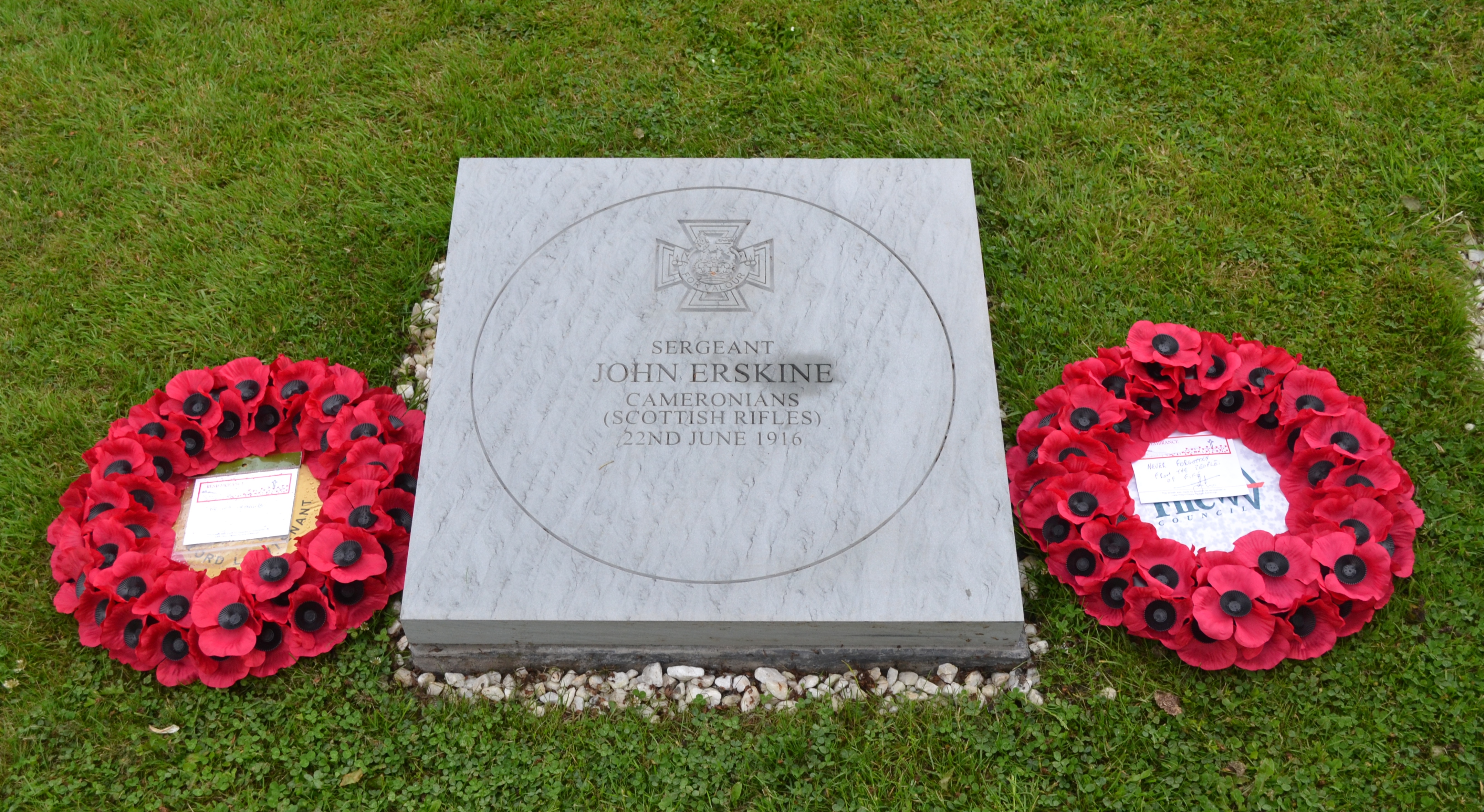
The commemorative stone to John Erskine VC, unveiled today in Dunfermline’s Garden for Heroes.
Comments:
Two Pals Remembered
Earlier this year, Low Parks Museum in Hamilton was host to the First World War partnership exhibition, Next of Kin, coordinated by National Museums Scotland. As part of this exhibition, a commemorative scarf was made by two volunteers from Hillhouse Parish Church. The hand-knitted scarf is a reference to the wartime effort by volunteers at home who would knit hats, scarfs, gloves and socks for the comfort of soldiers at the front.

Commemorative Scarf, created by volunteers for the ‘Next of Kin’ exhibition
The volunteers, Marion and Margaret, decided to create this scarf in the regimental colours of The Cameronians (Scottish Rifles), green, blue, and black, and used a thick, ribbed pleating to echo the pleats of a piper’s kilt. They also added the name ‘James Lusk’ to the scarf; Captain James Lusk featured in our display as part of the Next of Kin exhibition. James was a native of Strathaven, South Lanarkshire, and a manager in the famous iron and steel company David Colville & Sons. Tragically, James died on 28th December 1915, of serious wounds he had received on Christmas Day while handing out cigarettes to the men in his battalion.
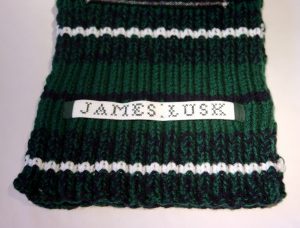
Captain James Lusk is commemorated on the scarf
While visiting The Cameronians displays in Low Parks Museum, Margaret had seen the objects on display that tell the story of Alexander Harris and William Wilson, who were the the subject of a previous blog post. Touched by the story of the two young pals, Margaret and Marion decided to add their names to the scarf.
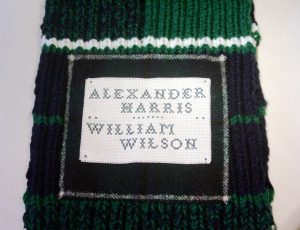
The names of Alexander Harris and William Wilson were added to the scarf, fixed to the same piece of Douglas tartan cloth
Margaret said that she had been struck by “how these young pals had enlisted together for Kitchener’s New Army, just like so many friends from every town, village and city throughout the country. The story of two ordinary boys who would become soldiers, signing up together with consecutive service numbers, just like so many others whose stories have been forgotten, and how they would have trained and fought together and for one of them to ultimately die and just how devastating this must have been to the other.”
You can see the scarf on display at Low Parks Museum, alongside a photograph of Alexander and William.
-

-
William (left) and Alexander
-
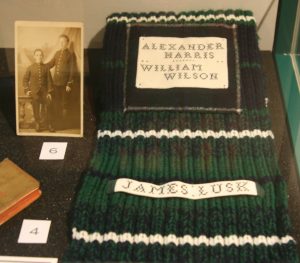
-
The scarf on display at Low Parks Museum
We would like to thank Margaret and Marion for all their hard work.
The Next of Kin exhibition is currently on tour, for venue details and dates please see the National Museums Scotland website for details – http://nms.ac.uk/national-international/sharing-collections/touring-and-lending/next-of-kin/touring-exhibition/
Comments:
Log in

